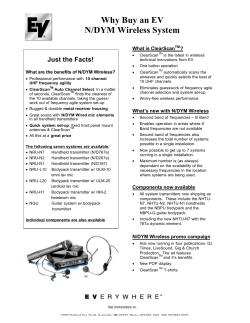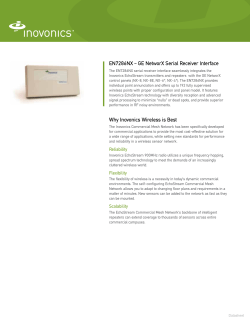
MIMO Broadcasting for Simultaneous Wireless Information
1
MIMO Broadcasting for Simultaneous Wireless Information
and Power Transfer: Weighted MMSE Approaches
arXiv:1410.4360v1 [cs.IT] 16 Oct 2014
Changick Song, Cong Ling, Jaehyun Park, and Bruno Clerckx
Abstract—We consider simultaneous wireless information and
power transfer (SWIPT) in MIMO Broadcast networks where
one energy harvesting (EH) user and one information decoding
(ID) user share the same time and frequency resource. In contrast
to previous SWIPT systems based on the information rate, this
paper addresses the problem in terms of the weighted minimum
mean squared error (WMMSE) criterion. First, we formulate
the WMMSE-SWIPT problem which minimizes the weighted
sum-MSE of the message signal arrived at the ID user, while
satisfying the requirement on the energy that can be harvested
from the signal at the EH user. Then, we propose the optimal
precoder structure of the problem and identify the best possible
MSE-energy tradeoff region through the alternative update of
the linear precoder at the transmitter with the linear receiver
at the ID user. From the derived solution, several interesting
observations are made compared to the conventional SWIPT
designs.
I. I NTRODUCTION
In recent years, it has been recognized that radio frequency
(RF) signals that transport information can at the same time
be exploited as significant energy source for devices that
are capable of harvesting RF energy to power themselves.
For this reason, simultaneous wireless information and power
transfer (SWIPT) has appeared as promising technologies in
conjunction with energy harvesting (EH) devices for providing
energy constrained wireless networks with convenient and
perpetual energy supplies [1] [2].
In SWIPT systems, efficient transmitter designs have been
active research area over the last few years as in [3]–[7]
and references therein. For example, various beamforming
strategies have been proposed in multi-antenna networks such
as interference [3], relaying [4], and broadcast channels (BC)
[5] [6] to maximize the rate at the information decoding (ID)
users and the harvested energy at the EH users simultaneously. Especially in [7], the authors completely characterized
the rate-energy tradeoff region by suggesting the optimum
precoder for multiple-input multiple-output (MIMO) two-user
BC SWIPT where one EH user and one ID user share the
same spectrum resource.
C. Song is with the Dept. of Information and Communications Eng.,
Korea National University of Transportation, Chungju, Korea (e-mail:
c.song@ut.ac.kr).
J. Park is with the Dept. of Electronics Eng., Pukyong National University,
Busan, Korea (e-mail: jaehyun@pknu.ac.kr).
C. Ling is with the Dept. of Electrical and Electronic Eng., Imperial
College, London, UK (e-mail: c.ling@imperial.ac.uk).
B. Clerckx is with the Dept. of Electrical and Electronic Eng., Imperial
College, London, UK and the School of Electrical Eng., Korea University,
Seoul, Korea (e-mail: b.clerckx@imperial.ac.uk).
While such information rate based designs may be useful
for evaluating the system performance, it may not be realistically implementable due to high encoding and decoding
complexity. As a low complexity alternative, linear receivers
such as the minimum mean squared error (MMSE) have
also been widely proposed in conventional communication
networks where the information transfer was the only concern
[8]–[10]. Surprisingly, however, there is no earlier contribution
on the linear receiver issue in the context of SWIPT systems.
As an initial step, our work develops a new design method
of the transmitter and ID receiver in terms of the MMSE for
MIMO BC SWIPT where an EH user and an ID user are
located separately, and identify the best possible MSE-energy
tradeoff region.
To get a better handle on the stream-wise error performance,
we formulate a weighted MMSE (WMMSE) SWIPT problem
which minimizes the weighted sum errors for the ID user
while satisfying the predetermined EH constraint for the EH
user. The weight matrix makes the problem generally nonconvex; thus more challenging than the equal weight cases.
To solve the problem, we first focus on the transmitter side for
a given ID receiver and derive the solution as a semi-closedform that can be obtained by simple bisection methods. It is
then observed that when the ID user has a single antenna,
the derived precoder reduces to the optimal beamformer that
maximizes the signal-to-noise ratio (SNR) corresponding to
the maximum information rate scheme in [7]. It is particularly
interesting to observe that while the proposed solution is
attainable by a simple bisection method, the previous design
in [7] still needs to compute complicated ellipsoid methods to
arrive at the same point.
Meanwhile, for a given the precoder, the optimal ID receiver
is simply the Wiener filter [11]. Thus, we can easily optimize
the transceiver through the alternative update process. Due
to the non-convexity of the problem, our solution may not
ensure the global optimality, but multiple initial points may
take us closer to the optimal point. Thus, the resulting MSEenergy region will carry a significant meaning as an MMSE
counterpart of the rate-energy region in [7]. Simulation results show that our solution exhibits improved bit error rate
(BER) performance and convergence rate compared to the
conventional rate-based designs. In addition, when we set the
weight matrix to be equal to the eigenvalue matrix of the ID
user channel, interestingly it is observed that the proposed
precoder achieves almost every boundary points of the rateenergy region suggested in [7].
Notations: Normal letters represent scalar quantities, boldface letters indicate vectors and boldface uppercase letters
of the EH user, the MMSE optimum transmitter design which
we denote by FID is well investigated in literature [8].
In the meantime, the total harvested energy at the EH
receiver, defined by Q, can be expressed as
.
.
.
G
EH User
F
Q = δE[kGFxk2 ] = Tr(FH GH GF)
Transmitter
H
.
.
.
x
..
.
L
xˆ
ID User
Fig. 1. A MIMO broadcast system for joint wireless information and energy
transfer with linear transceiver
designate matrices. The superscripts (·)T , (·)H , and E[·] stand
for the transpose, the conjugate transpose, and the expectation
operators, respectively. IN is an N × N identity matrix. In
addition, Tr (A), |A|, and kAk2 indicate the trace, the determinant, and the matrix 2-norm of a matrix A, respectively.
II. S YSTEM M ODEL & P ROBLEM F ORMULATION
As shown in Figure 1, we consider a wireless multi-antenna
broadcast system where one transmitter equipped with NT
antennas transmits radio signals to one EH user with NEH
antennas and one ID user with NID antennas at the same
time and frequency. Each user is chosen from the “near-far”
based scheduling at the transmitter, i.e., the closest user to
the transmitter is scheduled as a EH user and the other one,
further away, as an ID user. We assume that the two users
are physically separated, but it can be easily extended to
the co-located cases by applying a power splitting method in
[7]. In this paper, we assume quasi-static flat fading channels
so that the base-band channels from the transmitter to the
EH and ID receivers are simply represented by complex
matrices H ∈ CNID ×NT and G ∈ CNEH ×NT , respectively.
It is also assumed that the transmitter knows all channel
state information (CSI) H and G, and each user knows
the corresponding CSI. Considering the spatial multiplexing
scheme, we transmit NS data-streams simultaneously using
the input signal vector x ∈ CNS ×1 with E[xxH ] = INS .
ˆ ∈ CNS ×1
With these assumptions, the estimated signal x
at the ID user can be modeled by
ˆ = L(HFx + n),
x
(1)
where n ∈ CNID ×1 indicates the receiver noise with n ∼
CN (0, INID ), L ∈ CNS ×NID represents the linear receiver
at the ID user, and F ∈ CNT ×NS is the linear precoder
at the transmitter, which is subject to the power constraint
Tr(FFH ) ≤ PT . Then, the estimation error at the ID user can
ˆ − x and the resulting weighted sumbe defined as e = γ −1 x
MSE is given by MSE = Tr(WE[eeH ]). Here, the scaling
parameter γ −1 plays a role of automatic gain control [12]
which helps simplifying the derivation and W stands for a
real diagonal weight matrix. Note that without consideration
(2)
where δ is a constant accounting for the harvesting efficiency
and we assume δ = 1 for simplicity unless stated otherwise.
√
Let g1 and vg,1 ∈ CNT ×1 denote the largest singular
value of G and the corresponding right singular vector,
respectively.
√ Then, it is known that the energy beamformer
FEH = PT [vg,1 0NT ×(NS −1) ] achieves the maximum energy Emax = PT g1 [3] [7]. and we denote the achievable
sum-MSE with this beamformer by MEH . Meanwhile, the
sum-MSE and the energy attainable by the MMSE precoder
FID are denoted by Mmin and EID , respectively.
Now, consider the case where both the EH and ID users
co-exist. Then, the achievable MSE-energy region is
n
RM,E , (M, E) : M ≥ Tr(WE[eeH ]),
o
E ≤ Tr(FH GH GF), Tr(FFH ) ≤ PT ,
and each boundary point of RM,E can be obtained by solving
the following SWIPT-WMMSE optimization problem
min
γ,F,L
s.t.
Tr(WE[eeH ])
¯ Tr(FFH ) ≤ PT ,
Tr(FH GH GF) ≥ E,
(3)
¯ ≤ Emax . This problem is convex over the
where EID ≤ E
transmitter (receiver) when the receiver (transmitter) and γ are
given, and strictly quasi-convex with respect to γ when both
F and L are given. However, it is generally non-convex on
{γ, F, L}. Our goal of the paper is to find efficient solutions to
problem (3) and identify the best possible MSE-energy region
RM,E .
III. W EIGHTED MMSE T RANSCEIVER D ESIGNS
In this section, we solve the problem (3) based on the
Karush-Kuhn Tucker (KKT) conditions. First, we propose the
optimum precoder structure in terms of the WMMSE, and then
suggest alternative optimization process between the transmitter and the ID receiver. Several interesting observations will
also be made when the ID user is equipped with a single
antenna.
Using the expression of e and the assumptions made in the
previous section, we formulate the Lagrangian as
L(λ, µ, γ, F, L)
= Tr W(γ −1 LHF − INS )(γ −1 LHF − INS )H
¯
+Tr γ −2 WLLH − λ Tr(FH GH GF) − E
+µ Tr(FH F) − PT .
(4)
Then, the following KKT conditions provide necessary conditions for optimality:
LHFFH HH + L = γFH HH
¯ H GF + µ
HH LH WLHF − λG
¯F = γHH LH W
Tr WLHFFH HH LH + WLLH
= γTr FH HH LH W
¯ Tr(FH F) ≤ PT
λ ≥ 0; µ ≥ 0; Tr(FH GH GF) ≥ E;
µ
¯ Tr(FH F) − PT = 0
¯ Tr(FH GH GF) − E
¯ = 0,
λ
(5)
(6)
(7)
(8)
(9)
(10)
Here, Y is a positive definite matrix, but Z is in general
positive indefinite which makes the analysis challenging.
Based on these results, each of the transmitter and the receiver
can be optimized separately as in the following theorems.
Theorem 1: When L is given arbitrarily, the solutions of
problem (3) are attained by
¯ = γˆ Y − λZ
¯ −1 HH LH W,
¯ λ)
γˆF(
(11)
q
PT
Defining J(x)
=
where γˆ
=
¯ ¯ ¯ ¯ H .
Tr(F(λ)
F(λ) )
H ¯
¯
¯
Tr F(x) ZF(x) , if J(0) ≥ 0, we have λ = 0 and
¯ satisfying J(λ)
¯ = 0 can
otherwise, a unique optimal λ
¯
always be found over the range 0 < λ < 1/κ by simple line
search methods where κ , kZY −1 k22 .
Proof: Let us first consider the Lagrange dual function
g(λ, µ) = minγ,F L(λ, µ, γ, F, L) with fixed λ, µ, and L.
Then, ignoring constant terms, the problem of minimizing L
over F and γ is equivalently
min γ −2 Tr(FH KF) − 2γTr(ℜ(WLHF)) ,
γ,F
γTr(FH HH LH W)
¯ H GH GF + µ
= Tr(FH HH LH WLHF − λF
¯FH F)
H H H
¯E
¯+µ
= Tr(F H L WLHF) − λ
¯PT
= Tr(WLHFFH HH LH ) + Tr(WLLH ),
¯ , λγ 2 , µ
where λ
¯ , µγ 2 , and equations (5)-(7) are
derived from the zero gradient conditions by using some
rules of differentiation [13] and (9) and (10) come from the
complement slackness conditions.
Now, let us define two matrices that will be used for our
derivations as
Tr(WLLH )
H H
Y =
H L WLH +
INT
PT
¯
E
Z =
GH G −
IN .
PT T
ˆ =
F
ˆ = γK−1 HH LH W. Also, from (6)-(8), it follows
that F
(12)
¯ HG + µ
where K , HH LH WLH − λG
¯INT . Now, suppose
that at least one eigenvalue of K is a non-positive real number
with corresponding eigenvector v ∈ CNT ×1 . Then, it is easy
to show that problem (12) becomes unbounded below with
F = [v 0NT ×(NS −1) ] as γ → 0+ . Therefore, to obtain a
¯ and µ
bounded optimal value of problem (3), the optimal λ
¯
must always be chosen such that K ≻ 0.
Assuming K ≻ 0, we now obtain from KKT condition (6)
where the second equality is due to (8) and the last equality follows from (7). Comparing the last two, we can
H
¯¯
)
show that µ
¯ = λE+Tr(WLL
, which allows us to reduce
PT
¯ µ
¯
J(λ,
¯) to a simple one-dimensional dual function J(λ).
Since µ
¯ > 0, we also have Tr(FH F) = PT , i.e., γˆ =
¯ λ)
¯ F(
¯ λ)
¯ H ) 1/2 from (9).
PT /Tr(F(
Before we further proceed with our proof, let us show the
following two useful lemmas. The proofs can be found in
Appendix.
¯ takes a value over the range 0 ≤
Lemma 1: The optimal λ
¯
λ < 1/κ.
Lemma 2: J(x) is a monotonic increasing function for 0 ≤
x < 1/κ and limx→1/κ J(x) > 0.
With the aid of Lemma 1 and 2, the optimal dual
¯ which we denote by λ
ˆ can be obtained as
variable λ
follows:
We first see from the KKT condition (10) that
ˆ Tr(γ 2 F(
ˆ H GH GF(
ˆ −E
¯ λ)
¯ λ))
¯ = 0 must be satisfied,
λ
ˆ λ)
ˆ = 0. Therefore, if J(0) ≥ 0, we
which implies that λJ(
ˆ
¯ > 0 for λ
¯ > 0. In contrast, if
attain λ = 0, because J(λ)
ˆ
ˆ =0
J(0) < 0, one can find a unique λ 6= 0 satisfying J(λ)
¯
by simple line search methods over 0 < λ < 1/κ, since
ˆ must always
J(1/κ) > 0. It is worthwhile noting that J(λ)
¯ is not
be 0 or positive, because otherwise, the target energy E
attainable at the EH receiver. Finally, as the solution satisfying
the KKT conditions (6)-(10) is unique, the resulting precoder
(11) is also sufficient for the optimality, and the proof is
completed.
Theorem 2: When γ and F are given, the solution of
problem (3) is expressed as
ˆ = γFH HH (HFFH HH + INID )−1
L
(13)
Proof: The proof is trivial; thus omitted.
Algorithm 1 WMMSE Optimization Method
for j = 1 : NG do
1/2
¯H
¯ j and γj = PT /Tr(F
¯ jF
Initialize F
j )
repeat
¯ j and γj
Compute Lj using (13) with given F
¯
Update Fj = γj Fj using (11) with given Lj
until Fj converge to the prescribed accuracy
end for
Select the best solution among (Fj , Lj )|j = 1, . . . , NG ,
which shows the minimum sum-MSE
Based on results in Theorem 1 and 2, the problem (3) can
be solved in an alternating fashion between the transmitter
and the receiver as summarized in Algorithm 1. The sumMSE monotonically decreases by each transmit and receive
processing update. Therefore, the inner-iteration of Algorithm
IV. N UMERICAL R ESULTS
In this section, we provide several interesting observations
by comparing the numerical performance of the two MIMO
BC SWIPT design criteria: WMMSE and the information
rate [7]. Key system parameters are summarized in Table
I. Throughout our simulation, the channels are generated
−3/2 e
from Rayleigh fading pathloss model, H = dh H
and
(a) θ=111 (Emax=662µW) and W=I4
0.2
10
SWIPT−Rate [7]
MSE
NG=1,2,20
SWIPT−WMMSE
−0.2
10
−0.6
10
0
5
10
15
20
25
30
35
40
Number of iterations
(b) θ=111 (Emax=662µW) and W=ΛH
Rate (bps/Hz)
24
22
20
18
16
SWIPT−Rate [7]
SWIPT−WMMSE
NG=1,2,20
14
0
5
10
15
20
25
30
35
40
Number of iterations
Fig. 2. Sum-MSE and rate performance comparison of the two MIMO BC
¯ = Emax /2
SWIPT methods with E
θ=11 and Emax=32.9µW
35
30
(MEH,Emax)
25
Energy (µW)
1 guarantees the convergence at least to a local minimum.
However, due to joint non-convexity of problem (3), numerous
initial points which we denote by NG are employed so that the
resulting local minimum gets closer to the global minimum.
This requires additional outer loop iterations.
Next, let us examine the optimal beamforming solutions
with NID = NS = 1 for the special cases where the ID
receiver or both the ID and EH receivers have a single antenna.
In this case, the transmit matrix F reduces to a column vector
f ∈ CNT ×1 , the receive matrix L is equivalent to a scalar
value l ∈ C, and the weight matrix W can be ignored without
loss of generality.
Corollary 1: In the case of MISO channel from the transmitter to the ID receiver, i.e., H ≡ hH with h ∈ CNT ×1 ,
the MMSE optimal beamformer, which is independent of the
receiver l, is given by
1
ˆf = γˆ¯f = γˆ A−1 h
,
(14)
1 + hH A−1 h
p
¯ where λ
¯ is
where γˆ = PT /k¯fk2 and A , PT−1 INT − λZ
¯
obtained as follows: If J(0) ≥ 0, we set λ = 0 and otherwise,
¯ satisfying J(λ)
¯ = 0 by simple line search
we find a unique λ
¯
methods over 0 < λ < 1/ζ with ζ = kZ(hhH + P1T INT )−1 k22 .
Proof: Assuming NS = NID = 1 and following similar
approaches as in Theorem 1, the KKT conditions (5)-(10) lead
to the solution
−1
ˆf = γ hhH + 1 IN − νZ
hl−1 ,
(15)
PT T
p
¯ and γ = PT /k¯fk2 and ν is chosen to
where ν , |l|−2 λ
satisfy νJ(ν) = 0 over the range 0 ≤ ν < 1/ζ. Since a
particular choice of l has no influence on the optimal value of
ν and the resulting MSE of (15), i.e., E = (1 + hH A−1 h)−1
[11] is independent of l, setting l = 1 will not hurt the generality. Finally, by invoking some matrix inversion lemma, (15)
is alternatively expressed as f = γA−1 h(1 + hH A−1 h)−1 ,
and the proof is completed.
In fact, when we deal with a single stream transmission, i.e.,
NS = 1, the MMSE beamforming also maximizes the endto-end SNR which leads to the maximum information rate [9]
[11]. Therefore, our beamforming strategy in Corollary 1 is
essentially equivalent to one in [7, Corollary 3.1] which was
developed for the rate maximization. Interestingly, it is shown
that while the previous approach [7] requires a complicated
optimization tool such as the ellipsoid method to obtain the
solution, our method enables us to achieve the maximum
rate by a semi-closed-form solution that can be solved by
a simple bisection method; thus, providing more insights into
the system as well as complexity reduction.
20
15
(Mmin,EID)
10
5
0.5
SWIPT−Rate [7]
SWIPT−WMMSE
1
1.5
2
2.5
3
3.5
4
MSE
Fig. 3.
Achievable MSE-energy region of the two MIMO BC SWIPT
methods with PT = 10mW and W = I4
−3/2 e
e and G
e is drawn
G where each element of H
G = dg
from the i.i.d. CSCG normal distribution according to the
MATLAB code with the seed number θ as in Table I. Also, we
set NT = NS = NID = NEH = 4 and dh = dg = 10(m) for
the ease of the presentation. Let us assume that PT = 20 dBm
(100mW ). Then, since the noise power is −100 dBm/Hz ×
100MHz=1µW , the per-antenna SNR at the ID user becomes
20 − 30 − (−30) = 20 dB, which is equivalent to the standard
signal model with PT = 105 in (1). Thus, 1 energy unit at the
EH user in (2) amounts to 1µW in our simulation setting.
Figure 2-(a) and 2-(b) illustrate the convergence trends
TABLE I
S YSTEM PARAMETERS
Noise Power Spectral Density
Energy Conversion Efficiency
Pathloss Exponent
Signal Bandwidth
Distance: Tx - ID receiver
Distance: Tx - EH receiver
−100 dBm/Hz
50% (δ = 0.5)
3
10 MHz
dh (m)
dg (m)
Channel Realization
(MATLAB Code)
randn(‘state’,θ);
e = (randn(NID , NT ) + j ∗ randn(NID , NT ))/sqrt(2);
H
e = (randn(NEH , NT ) + j ∗ randn(NEH , NT ))/sqrt(2);
G
1 Similar observation has been made in point-to-point MIMO systems
without energy transfer [8]
θ=11 and Emax=32.9µW
35
30
(REH,Emax)
Energy (µW)
25
20
15
(Rmax,EID)
10
5
0
SWIPT−Rate [7]
SWIPT−WMMSE
0
2
4
6
8
Rate (bps/Hz)
10
12
14
Fig. 4.
Achievable Rate-energy region of the two MIMO BC SWIPT
methods with PT = 10mW and W = ΛH
Uncoded BER with 4QAM
0
10
−1
10
Average BER
of the proposed scheme with PT = 100mW in terms of
both the sum-MSE and the information rate with weight
matrices W = I4 and W = ΛH , respectively, where ΛH
indicates the eigenvalue matrix of HH H. In each iteration,
the sum-MSE (M ) and the rate (R) are computed from M =
Tr(W(FH HH HF + INT )−1 ) and R = log |FH HH HF +
INT | under the assumption that the ID user employs the
MMSE receiver (13) and the maximum likelihood receiver,
respectively. Due to the non-convexity of problem (3), the
resulting performance depends on the number of initial points
and iterations, especially when the weight matrix is nonidentity. Nevertheless, it is seen that 20 random initial points
and 10 number of iterations seem to be sufficient to achieve
the converged performance for our scheme. It is somewhat
natural that the proposed MMSE scheme obtains improved
MSE performance over the “SWIPT-Rate” scheme [7]. However, it is particularly interesting to observe that our solution
achieves the optimum rate as well when the weight factors
are properly chosen, which implies that the rate maximizing
precoder design can be regarded as a special case of our
WMMSE design1 . Extensive computer simulations confirm
that W = ΛH is the best choice for maximizing the rate,
but rigorous proof remains open.
Figures 3 and 4 illustrate the boundary points of the
achievable MSE-energy and rate-energy regions, respectively.
20 random initial points are used for the proposed SWIPTWMMSE scheme. It is shown that our solution achieves the
outstanding MSE-energy region compared to the SWIPT-Rate
scheme [7], which leads to the BER performance improvement
as is shown later. In addition, Figure 4 shows that when
W = ΛH , the WMMSE precoder achieves almost every
boundary points of the optimal rate-energy region; thus,
confirming the previous observation made in Figure 2. We
would like to note that although here we presented simulations
results for a sample channel (θ = 11), the trend does not
change for all channel realizations.
Figure 5 compares the uncoded BER performance of the
two MIMO BC SWIPT systems with 4QAM. We averaged
over 105 random channel realizations and set E¯ = Emax /2 in
each realization so that the EH user harvests at least 50% of
the maximum energy allowed for a given channel. The figure
shows that the proposed MMSE scheme with W = I4 obtains
approximately 5 dB gain over the SWIPT-Rate scheme. This is
−2
10
SWIPT−Rate [7]
SWIPT−WMMSE
−3
10
0
5
10
15
PT (dBm)
20
25
30
Fig. 5. BER performance comparison of the two MIMO BC SWIPT methods
¯ = Emax /2
with W = I4 and E
because the rate-based precoder allocates more resource to the
stronger sub-channel, while the MMSE precoder neutralizes
the channel gains across sub-channels. On the contrary, for the
same reason, the rate-based design may exhibit better error
performance when the transmitter adopts sufficiently strong
channel codes. The proposed WMMSE precoder will softly
bridge two extreme cases by adjusting the weight matrix W.
V. C ONCLUSION
In this paper, we investigated efficient linear transceiver
designs for MIMO BC SWIPT systems which minimizes the
weighted sum-MSE of the ID-user while satisfying the energy
harvesting constraint of the EH-user. First, we identified the
optimal precoder structure as a closed-form solution that can
be obtained by simple bisection methods. Then, it was shown
that the derived precoder achieves the maximum SNR at the
ID user with reduced complexity when the ID user has a single
antenna. Second, we suggested alternative updating process
to obtain the joint WMMSE solution with the ID receiver.
Although the problem is non-convex, it is observed from
simulation results that our solution with multiple initial points
approaches the best possible MSE-energy tradeoff region. It
was also interesting to observe that the proposed WMMSE
precoder with W = ΛH achieves almost every boundary
points of the optimal rate-energy region.
VI. ACKNOWLEDGEMENT
This work was supported in part by FP7 project PHYLAWS
(EU FP7-ICT 317562).
A PPENDIX
A. Proof of Lemma 1
¯¯
H
)
Using µ
¯ = λE+Tr(WLL
, the feasibility condition K ≻ 0
PT
¯
¯ < 1/κ
is equivalently Y ≻ λZ, which holds if and only if λ
where κ indicates the maximum eigenvalue of a matrix ZY−1 .
Note that the maximum eigenvalue of a matrix is equivalent
to its matrix two norm [14]. Therefore, combining with the
condition λ ≥ 0 in (8), we obtain Lemma 1.
B. Proof of Lemma 2
On the one hand, we first set the derivative of the function
J(x) with respect to x as
¯
∂J(x)
∂J(x) T ∂ F(x)
= Tr
¯
∂x
∂x
∂ F(x)
¯
2
H ∂ F(x)
¯
.
(16)
= Tr γ [ZF(x)]
∂x
In addition, taking a derivative at both sides of the equation
¯
(6), i.e., KF(x)
= HH LH W, we have
¯
∂ F(x)
∂ ¯ ¯
KF(x) = −ZF(x)
+K
= 0,
∂x
∂x
¯
(x)
¯
which gives us ZF(x)
= K ∂F
∂x . Then, plugging this result
back into (16), it follows
H ¯
!
¯
∂ F(x)
∂ F(x)
∂J(x)
2
,
= Tr γ
K
∂x
∂x
∂x
which implies that as long as K ≻ 0 (or x < 1/κ), J(x) is a
monotonic increasing function of x.
On the other hand, applying the obtained precoder (11) to
J(x), it is rewritten by
J(x) = Tr WH LH HH (Y − xZ)−1 Z(Y − xZ)−1 HLW
= Tr WH LH HH (INT − xZY−1 )−1
×Y−1 Z(Y − xZ)−1 HLW .
This result implies that as x → 1/κ, J(x) will have an
infinitely large number (+∞ or −∞) due to the inverse
operation of a rank deficient matrix INT − κ−1 ZY −1 . As
shown previously, J(x) is increasing function over x < 1/κ,
and thus we have limx→1/κ J(x) → +∞, and the proof is
concluded.
R EFERENCES
[1] P. Grover and A. Sahai, “Shannon meets Tesla: Wireless information and
power transfer,” in Proc. IEEE International Symposium on Information
Theory (ISIT’10), pp. 2363–2367, June 2010.
[2] L. R. Varshney, “Transporting information and energy simultaneously,” in Proc. IEEE International Symposium on Information Theory
(ISIT’08), pp. 1612–1616, July 2008.
[3] J. Park and B. Clerckx, “Joint wireless information and energy transfer
in a two-user MIMO interference channel,” IEEE Trans. Wireless
Commun., vol. 8, pp. 4210–4221, August 2013.
[4] A. A. Nasir, X. Zhou, S. Durrani, and R. A. Kennedy, “Relaying
protocols for wireless energy harvesting and information processing,”
vol. Available:http://arxiv.org/abs/1212.5406, 2012.
[5] J. Xu, L. Liu, and R. Zhang, “Multiuser MISO Beamforming for
Simultaneous Wireless Information and Power Transfer,” in Proc. IEEE
International Conference on Acoustics, Speech, and Signal Processing
(ICASSP), 2013.
[6] H. Son and B. Clerckx, “Joint beamforming design for multi-user
wireless information and power transfer,” to appear in IEEE Trans.
Wireless Commun.
[7] R. Zhang and C. K. Ho, “MIMO broadcasting for simultaneous wireless information and power transfer,” IEEE Trans. Wireless Commun.,
vol. 12, pp. 1989–2001, May 2013.
[8] H. Sampath, P. Stoica, and A. Paulraj, “Generalized linear precoder
and decoder design for MIMO channels using the weighted MMSE
criterion,” IEEE Trans. on Commun., vol. 49, pp. 2198–2206, Dec. 2001.
[9] D. P. Palomar, J. M. Cioffi, and M. A. Lagunas, “Joint Tx-Rx beamforming design for multicarrier MIMO channels: a unified framework for
convex optimization,” IEEE Trans. Signal Process., vol. 51, pp. 2381–
2401, September 2003.
[10] C. Song, K.-J. Lee, and I. Lee, “MMSE based transceiver designs in
closed-loop non-regenerative MIMO relaying systems,” IEEE Trans.
Wireless Commun., vol. 9, pp. 2310–2319, July 2010.
[11] M. Joham, W. Utschick, and J. A. Nossek, “Linear transmit processing
in MIMO communications systems,” IEEE Trans. Signal Process.,
vol. 53, pp. 2700–2712, August 2005.
[12] J. Joung and Y. H. Lee, “Regularized channel diagonalization for
multiuser MIMO downlink using a modified MMSE criterion,” IEEE
Trans. Sig. Process., vol. 55, pp. 1573–1579, Apr. 2007.
[13] A. Hjørungnes and D. Gesbert, “Complex-valued matrix differentialtion:
Techniques and key results,” IEEE Trans. Signal Process., vol. 55,
pp. 2740–2746, Jun. 2007.
[14] G. H. Golub and C. F. V. Loan, Matrix Computations. Third Edition,
The Johns Hopkins University Press, Baltimore and London, 1996.
© Copyright 2025













